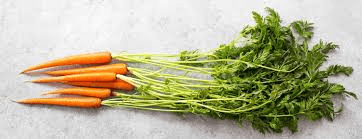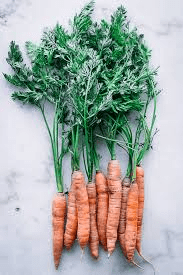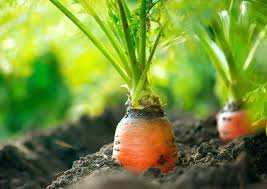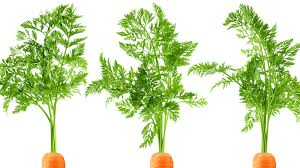Carrot leaves, the luscious green foliage that crowns the familiar orange root vegetable, play a crucial role in the plant’s life cycle and offer several intriguing characteristics worth exploring. Botanically known as Daucus carota, carrot leaves are part of the Apiaceae family, which includes other well-known members such as parsley, celery, and dill.
While often overshadowed by the vibrant taproot, carrot leaves possess their own unique attributes that contribute to the overall health and growth of the plant.
Structurally, carrot leaves exhibit a finely divided appearance, with feathery, fern-like leaflets branching out from a central stem. These compound leaves are arranged alternately along the stem, maximizing their exposure to sunlight for photosynthesis, the process by which plants convert light energy into chemical energy to fuel their growth.
The leaflets themselves are typically narrow and elongated, featuring serrated edges that enhance their surface area for optimal light absorption.
One notable feature of carrot leaves is their distinct aroma, which is reminiscent of the carrot itself. This aroma is attributed to compounds called terpenes, which are organic molecules responsible for the characteristic scents of many plants. In addition to contributing to the plant’s fragrance, terpenes may also serve as natural defenses against herbivores and pathogens, helping to protect the carrot plant from potential threats.
Like most plants, carrot leaves play a vital role in the process of transpiration, wherein water is absorbed by the roots and transported through the plant to the leaves, where it evaporates into the surrounding atmosphere. This continual movement of water helps to regulate the plant’s internal temperature and maintain turgor pressure, ensuring structural support and nutrient distribution throughout the plant.
Carrot leaves also serve as reservoirs of essential nutrients and secondary metabolites that contribute to the plant’s overall health and resilience. For example, they contain various vitamins, minerals, and antioxidants, including vitamin C, vitamin K, potassium, and beta-carotene, which have been linked to numerous health benefits for humans, such as immune support and antioxidant protection against cellular damage.
In addition to their nutritional value, carrot leaves possess allelopathic properties, meaning they release chemical compounds that inhibit the growth of neighboring plants. While this may seem counterintuitive, allelopathy can help prevent competition for resources like water, nutrients, and sunlight, thereby enhancing the carrot plant’s chances of survival and success.
Furthermore, carrot leaves have historically been used for culinary and medicinal purposes in various cultures around the world. While the taproot is the most commonly consumed part of the plant, carrot leaves can also be incorporated into dishes such as salads, soups, and pesto, adding a fresh, herbaceous flavor to culinary creations.
Additionally, traditional herbal remedies have utilized carrot leaves for their purported diuretic, anti-inflammatory, and digestive properties, although scientific research on their medicinal efficacy is limited.
Carrot leaves may not receive as much attention as their vibrant orange counterparts, but they are undeniably essential components of the carrot plant’s biology and offer a range of fascinating characteristics and potential uses.
From their structural adaptations for photosynthesis to their nutritional content and allelopathic properties, carrot leaves exemplify the intricate interplay between plants and their environments, underscoring the importance of appreciating the full complexity of the natural world.
The Economic Importance and Uses of Carrot Leaves

1. Nutrient Source: Carrot leaves are rich in vitamins, minerals, and antioxidants, making them a valuable addition to the diet. They contain significant amounts of vitamin K, which is essential for blood clotting and bone health.
2. Livestock Feed: Carrot leaves can be fed to livestock such as rabbits, goats, and cattle, providing a nutritious forage option, especially during periods of scarcity or drought.
3. Medicinal Purposes: Carrot leaves have been traditionally used in herbal medicine for their diuretic properties and as a remedy for digestive issues. They may also have potential anti-inflammatory and antibacterial effects.
4. Compost Material: Carrot leaves can be composted to create nutrient-rich organic matter, which can then be used to improve soil fertility and structure in agricultural fields and gardens.
5. Food Flavoring: In some culinary traditions, carrot leaves are used as a flavoring agent in soups, stews, and salads, adding a subtle earthy taste to dishes.
6. Pest Repellent: Extracts from carrot leaves have been shown to have insecticidal properties, making them potentially useful in organic pest control methods for crops.
7. Cosmetic Ingredients: Carrot leaf extracts are used in cosmetics and skincare products for their antioxidant properties, which help protect the skin from damage caused by free radicals.
8. Natural Dyes: The pigments present in carrot leaves can be used as natural dyes for textiles and crafts, producing shades ranging from yellow to green.
9. Herbal Tea: Dried carrot leaves can be brewed into a flavorful herbal tea, which is believed to have detoxifying and cleansing effects on the body.
10. Garnish: Fresh carrot leaves can be used as a decorative garnish for culinary dishes, adding visual appeal and a hint of freshness.
11. Aromatherapy: Carrot leaf essential oil, extracted from the leaves through steam distillation, is used in aromatherapy for its refreshing and uplifting scent.
12. Fodder: Carrot leaves can be dried and stored as fodder for livestock, providing a source of roughage and supplementary nutrition.
13. Traditional Crafts: In some cultures, dried carrot leaves are used in traditional crafts such as basket weaving or as stuffing material for pillows and cushions.
14. Natural Insect Repellent: Crushed or dried carrot leaves can be used as a natural insect repellent in homes and gardens, helping to deter pests such as mosquitoes and flies.
15. Educational Purposes: Carrot leaves are often used in educational settings to demonstrate plant anatomy and physiology, providing hands-on learning experiences for students.
16. Biofuel Production: Carrot leaves, along with other agricultural residues, can be processed into biofuels such as ethanol through fermentation and distillation processes.
17. Traditional Medicine: Some traditional medicine systems use carrot leaves to prepare herbal remedies for various ailments, including coughs, colds, and rheumatism.
18. Art and Craft Supplies: Dried carrot leaves can be used in art and craft projects, such as making handmade paper or creating natural dye paintings.
Read Also Scrapie in Sheep and Goats: Description, Damages Caused, Control and Preventive Measures
The Products and By-products That Can Be Derived From Carrot Leaves

1. Nutrient-Rich Compost: Decomposed carrot leaves can be used to create compost, which serves as an excellent soil conditioner and fertilizer for crops and gardens.
2. Herbal Extracts: Carrot leaf extracts can be obtained through various extraction methods and used in the formulation of herbal supplements, tinctures, and medicinal preparations.
3. Livestock Feed Additive: Dried and ground carrot leaves can be incorporated into livestock feed as a source of supplementary nutrition and flavor enhancer.
4. Organic Fertilizer: Liquid extracts or teas made from fermented carrot leaves can be used as organic fertilizers to promote plant growth and soil health.
5. Natural Pesticides: Carrot leaf extracts contain compounds that have insecticidal properties, making them useful in the formulation of natural pesticides and insect repellents.
6. Herbal Teas: Dried carrot leaves can be packaged and sold as herbal tea blends, offering consumers a caffeine-free beverage option with potential health benefits.
7. Cosmetic Ingredients: Extracts from carrot leaves can be used in the formulation of cosmetics and skincare products, including creams, lotions, and serums, for their antioxidant and anti-aging properties.
8. Animal Bedding: Dried carrot leaves can be shredded and used as bedding material for small animals such as rabbits, guinea pigs, and hamsters, providing them with a comfortable and absorbent bedding option.
9. Natural Dyes: Pigments extracted from carrot leaves can be used to dye natural fibers such as cotton, wool, and silk, producing vibrant and eco-friendly colors.
10. Herbal Remedies: Carrot leaves can be dried and powdered for use in traditional herbal remedies and folk medicine preparations for various health conditions.
11. Potpourri: Dried carrot leaves can be added to potpourri blends for their aromatic properties, imparting a fresh and earthy scent to the mixture.
12. Flavor Enhancer: Carrot leaf extracts can be used as a natural flavor enhancer in food and beverage products, adding depth and complexity to culinary dishes and beverages.
13. Natural Insect Repellents: Carrot leaf oils or extracts can be formulated into insect repellent sprays, creams, or candles, offering consumers a chemical-free alternative for pest control.
14. Biodegradable Packaging: Carrot leaves can be processed into biodegradable packaging materials, offering a sustainable alternative to traditional plastic packaging options.
15. Herbal Infusions: Fresh or dried carrot leaves can be steeped in hot water to create herbal infusions or decoctions, which can be consumed as a health-promoting beverage.
16. Animal Grazing: Carrot leaves can be left in the field after harvest for grazing by livestock, providing them with a source of fresh forage and supplemental nutrition.
17. Medicinal Poultices: Crushed or mashed carrot leaves can be applied topically as poultices or compresses to soothe insect bites, rashes, and minor skin irritations.
Read Also Management of Breeding Stock in Sheep and Goats
Frequently Asked Questions (FAQs) About Carrot Leaves

1. Are carrot leaves safe to eat?
Carrot leaves are safe to eat in moderate amounts, but they should be consumed in moderation due to their high levels of certain compounds that may be toxic in large quantities.
2. Can I use carrot leaves in my compost pile?
Yes, carrot leaves can be added to compost piles as a source of organic matter and nutrients. However, they should be chopped or shredded before adding to the compost to aid in decomposition.
3. Do carrot leaves have any nutritional value?
Yes, carrot leaves contain significant amounts of vitamins A, C, and K, as well as minerals such as calcium and potassium. They are also rich in antioxidants, which help protect against oxidative damage.
4. Can I feed carrot leaves to my pets?
Carrot leaves can be fed to certain pets such as rabbits and guinea pigs in small amounts as part of a balanced diet. However, they should not be fed to dogs or cats as they may cause digestive upset.
5. How do I prepare carrot leaves for cooking?
Carrot leaves can be prepared for cooking by washing them thoroughly under running water to remove any dirt or debris. Then, they can be chopped finely and added to soups, stews, salads, or sautéed as a side dish. It’s essential to ensure that only fresh, healthy carrot leaves are used for cooking, and any wilted or discolored leaves should be discarded.
6. Can I use carrot leaves to make pesto?
Yes, carrot leaves can be used as a substitute for basil in traditional pesto recipes. Simply blend fresh carrot leaves with garlic, nuts, Parmesan cheese, and olive oil until smooth. The resulting carrot leaf pesto can be used as a sauce for pasta, spread on sandwiches, or served as a dip for vegetables.
7. Are there any culinary traditions that use carrot leaves extensively?
In some Mediterranean and Middle Eastern cuisines, carrot leaves are used in a variety of dishes, including salads, soups, and pilafs. They are prized for their earthy flavor and nutritional benefits, adding depth and complexity to culinary creations.
8. Can I store carrot leaves for later use?
Fresh carrot leaves can be stored in the refrigerator for up to a week in a plastic bag or container with a damp paper towel to maintain freshness. Alternatively, they can be dried or frozen for longer-term storage. To freeze carrot leaves, blanch them in boiling water for a few seconds, then plunge them into ice water to stop the cooking process before freezing in airtight containers.
9. Are there any health benefits associated with consuming carrot leaves?
Yes, carrot leaves are rich in vitamins, minerals, and antioxidants, which offer numerous health benefits. They are particularly high in vitamin K, which is essential for blood clotting and bone health, as well as vitamin A, which supports vision and immune function. Additionally, the antioxidants found in carrot leaves help protect against chronic diseases and inflammation.
10. Can I use carrot leaves to make herbal remedies at home?
Yes, carrot leaves can be used to prepare homemade herbal remedies for various ailments. For example, a tea made from dried carrot leaves may help alleviate digestive issues or act as a mild diuretic. However, it’s essential to consult with a healthcare professional before using any herbal remedies, especially if you have underlying health conditions or are taking medications.
Read Also How to Make an Avocado Tree Bear Fruit






